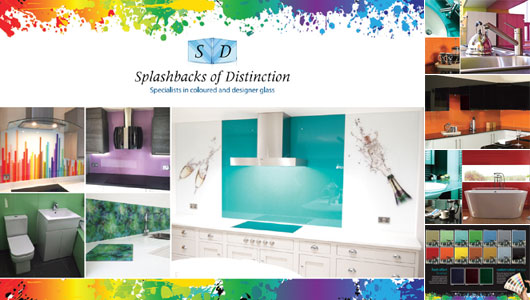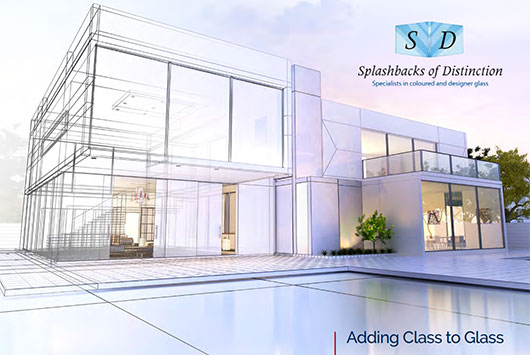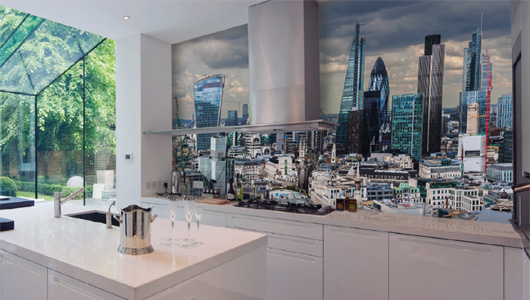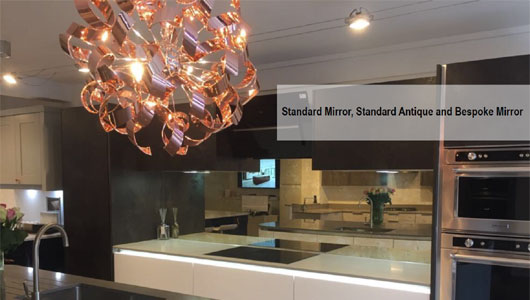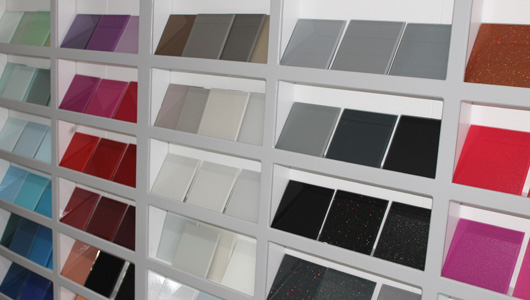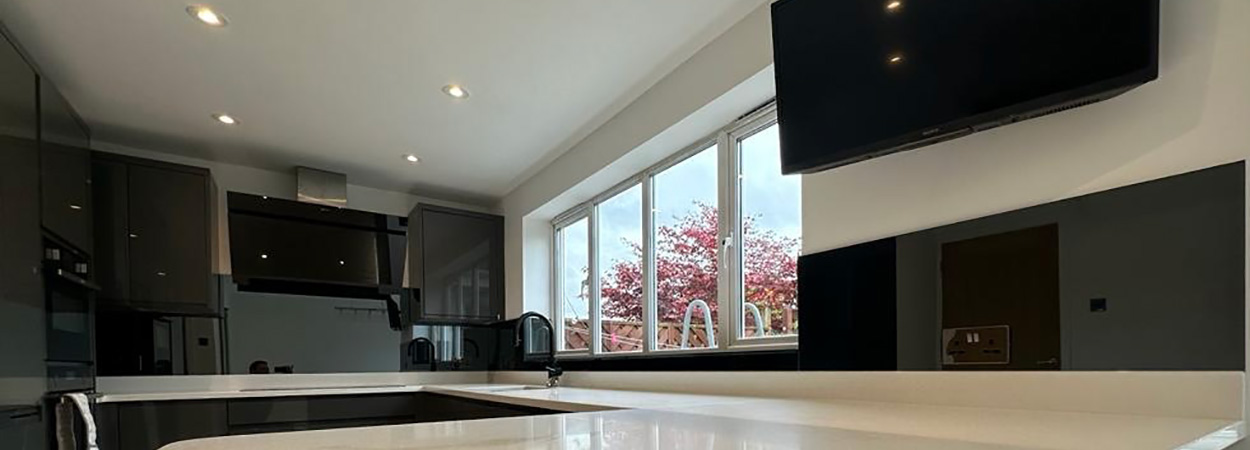
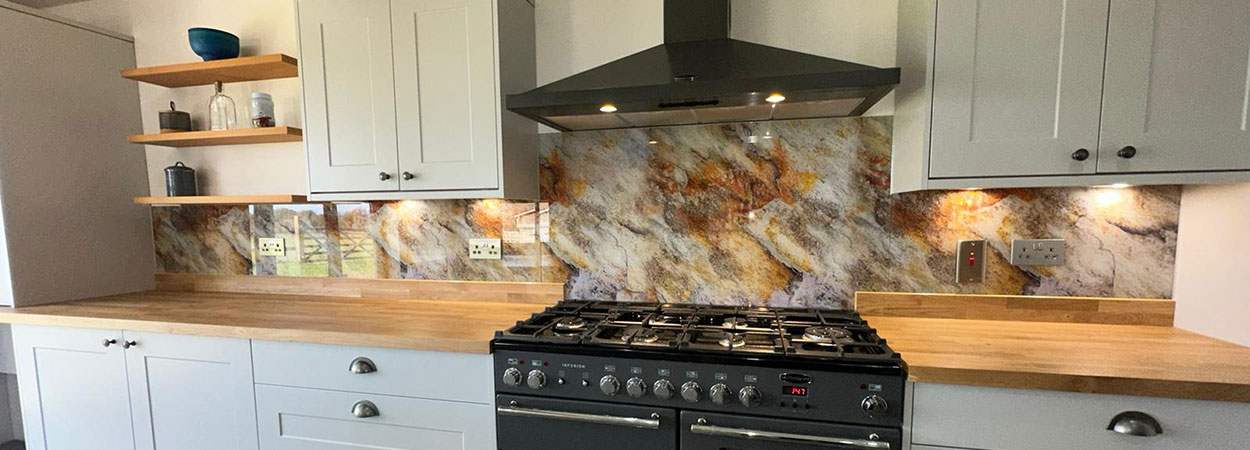
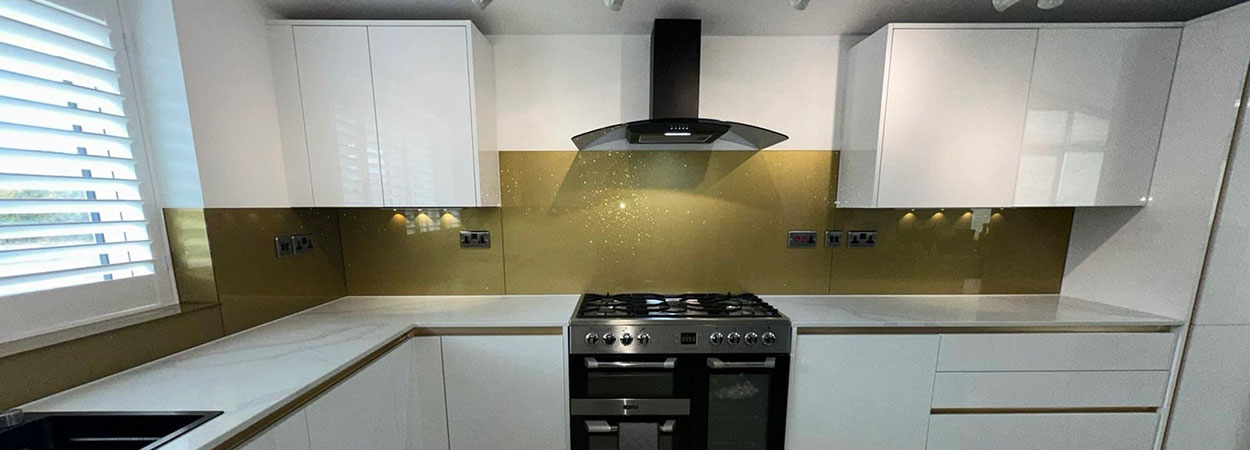
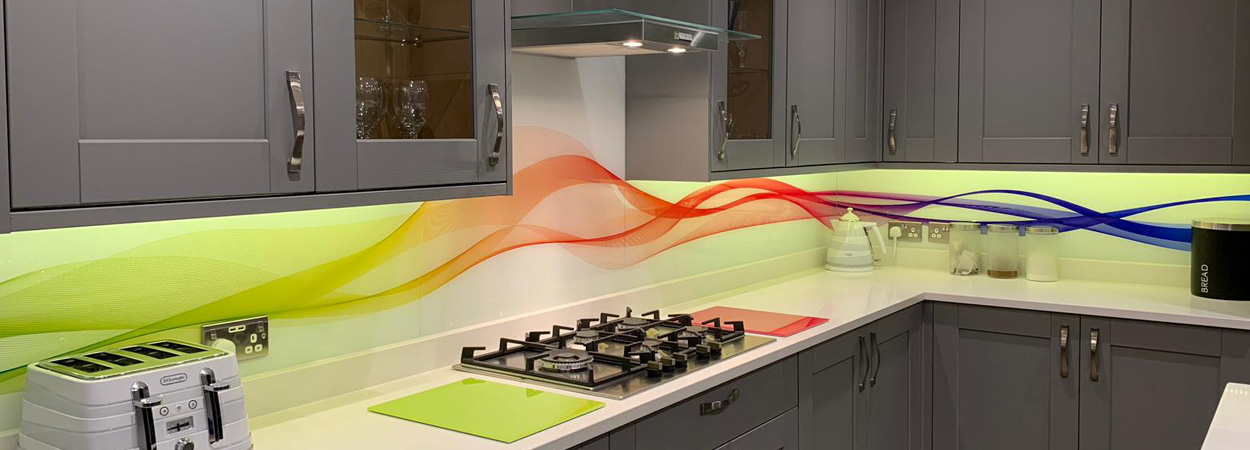
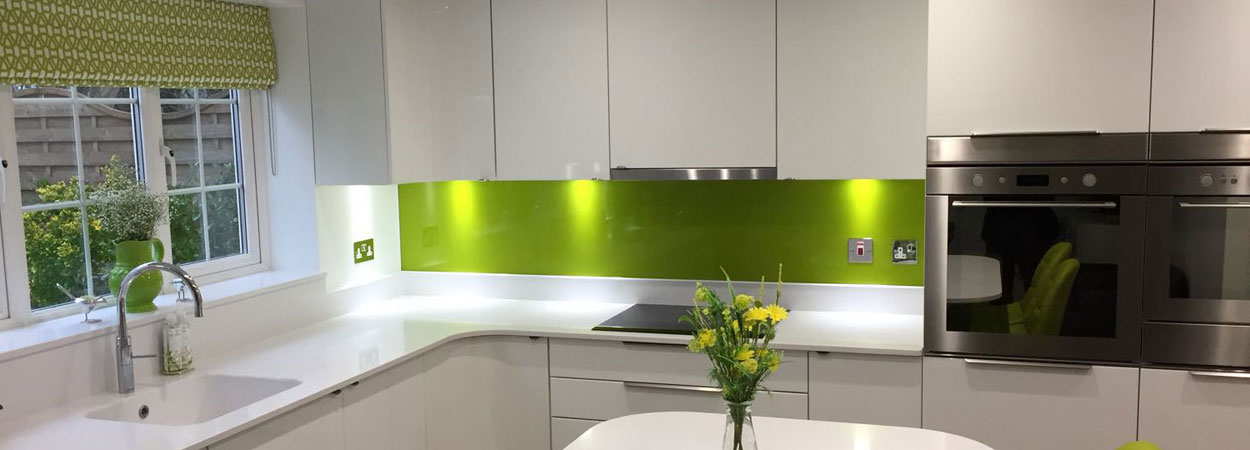
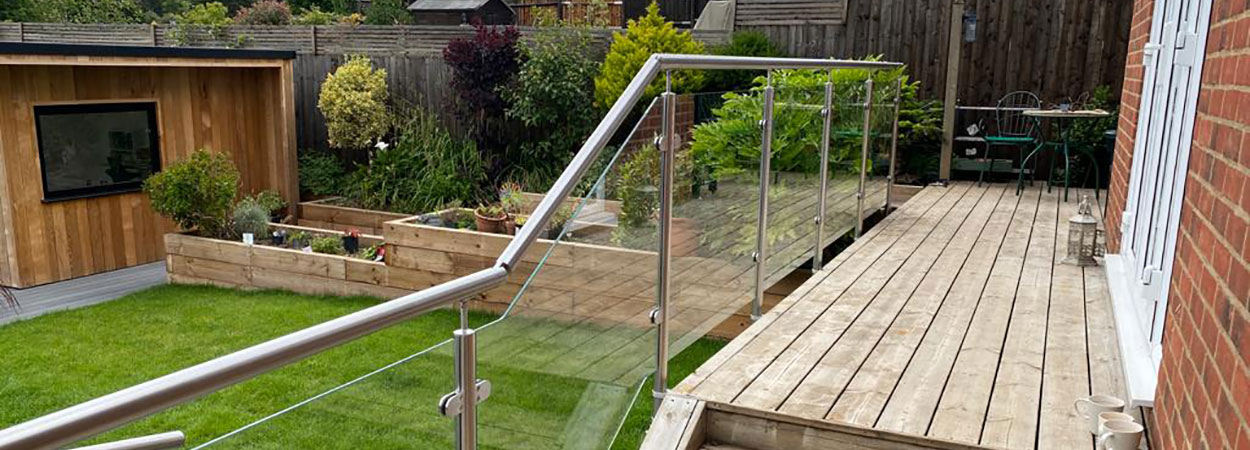


















Glass Splashbacks | Kitchen Splashbacks | Bathroom Splashbacks | Glass Balustrades | Finchley, London
Based in Stevenage, Hertfordshire, Splashbacks of Distinction have a real passion for toughened glass in and around the home. We have transformed many properties, both commercial and domestic with our glass splashbacks, for kitchens, bathrooms and living rooms. Our toughened glass balustrades, glass shelving and splashbacks with high resolution images have really caught the imagination of people who demand beauty and functionality in their homes and offices.












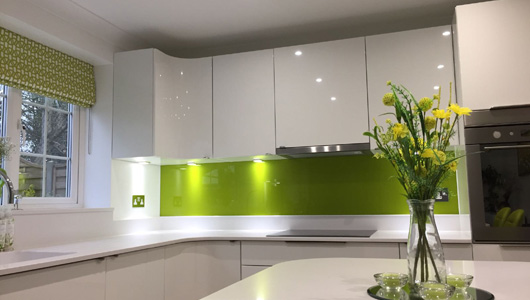
Splashbacks of Distinction
As one of the leaders in design and up to date technology, Splashbacks of Distinction are always on hand to deliver the highest standards of quality and service to our valued customers.
Splashbacks of Distinction provide a wonderful product that is suitable for kitchens, bathrooms, office spaces or anywhere you want a true touch of class.
Our splashbacks will add value and style to new and old kitchens and bathrooms. They are easy to clean and very hygienic. Every piece is toughened when manufactured so it is heat, water and impact proof.
A glass splashback and worktop will complement any bathroom, kitchen, bar area, laundry or shop. The sleek and seamless surface is the ultimate in elegance with zero visual interruption. Our glass splashbacks and worktops come in any colour and are also far easier to clean than ceramic tiles.
Should you require our services, please call or contact us by completing the simple contact form and we will get back to you as soon as possible.
Why not visit our show room or browse through our brochure
The Splashbacks of Distinction show room is located at Watton at Stone in Hertfordshire with easy access from Hertford, Stevenage and surrounding towns. It is close to both the A1 and A10 which makes it easily accessible from North London.
We have a wide range of samples, styles, colours and textures for you to see and touch. Our clients have told us that being able to visit our showroom really helps them to visualise and develop their ideas so that they really end up with exactly what they wanted. Our workshop is next to the showroom so you can also see our products as they are manufactured.
Hertfordshire Showroom Details
We have also created a stunning brochure with a selection from our range. This is available to download as a PDF by clicking on the link below.
Adding class to glass with our glass balustrades
Glass creates an illusion of more space and allows outside features to become part of the interior design. With glass it is possible to link two different spaces together without the barrier of a wall giving you the ability to enjoy your home and garden throughout the year.
Our frameless systems create a contemporary design which safely maximises any view, allowing natural light to spread across the living space. This solution can be used for internal stairs, external balconies, or to act as windbreaks in exposed areas outdoors.
Balustrade posts provide a classic, yet still very popular, design choice. Manufactured using 2.6mm thick walled, 48mm stainless steel for superior strength. This high quality, external grade steel maximises durability and minimises maintenance.
Glass spigots create a modern, minimalist design choice which maximises your view. Glass spigots are a large glass floor clamp that secures the glass vertically. The individual 'feet' allow for natural drainage making it an ideal choice for external areas including patio, and decked gardens, as well as poolside areas.
Massive range of printed splashbacks
The possibilities are almost endless. Whether you wish to modernise your home or office space, enhance it or create an eye-catching element in one of your rooms we are here to make your dream come true. Your wish is our command.
Perhaps a tropical landscape in the bathroom? How about a stylish banister or wall art? Or even a state-of-the art room divider?
If you own a business you might want to create a new inviting atmosphere for your customers or upgrade your existing space, making it uniquely stylish.
At Splashbacks of Distinction we can even recreate different surface patterns too. That wood-style surface you always wanted is now possible and it comes with all the advantages of glass. Our customers also love our granite and marble styles which are perfectly stunning.
NEW range of glass mirrors
When it comes to Mirrors, in either a Kitchen or Bathroom, nothing quite rivals the open, light and clean look that such a simple product offers.
Splashbacks of Distinction offer a range of standard mirrors available in Silver, Grey, Bronze and Peach with toughened options available.
Our bespoke antique mirrors offer depth and character, reflecting the beauty of its surroundings as well as enhancing them. Our collection of six unique mirrors can bring depth, glamour and a unique look to any space.
Choose from our range of antique mirror styles including moon, lava, mercury, Neptune, vincenzo, bronze vincenzo and bianco nero. Why not view our brochure or contact us today to see what we can do for you.
We can supply samples to help you choose
It is often very difficult to see what a particular colour or finish will look like from a picture. We understand that and can supply samples of your chosen splash back to enable you to get the best possible idea of what your dream kitchen or bathroom will look like before it is fitted.
We already have hundreds of samples available to look at in our showroom including different types of finishes such as glitter or sparkle. We can supply a sample in any colour or finish you would like from our extensive range.
Our splash backs are often so vibrant that it is very difficult to really appreciate them from a simple image and with some finishes, such as the mirrored finishes, it is virtually impossible. With a sample you can get a much clearer idea of how your splash back will look in your kitchen and how it will compliment the other colours and textures around it.
A complete service from measuring to final installation
At Splashbacks of Distinction we carefully manage the complete production, design and fitting of our bespoke, designer glass splashbacks.
Great care is taken to measure the intended space and our team will discuss your requirements and help with any ideas you have. Once we have finalised your design with our team, Splashbacks of Distinction can start to make the magic happen.
At every stage of the production process each of our panels is quality checked. Once one of our panels has left our workshop, we at Splashbacks of Distinction transport it and install it. Because each design is unique, it requires specialist knowledge to ensure correct fitting. Our team of experienced fitters will ensure that the panels are correctly aligned and mounted. We won't be happy until our customer is completely happy with the result.
Our team will work closely with you to create your dream design, ensuring the highest quality from start to finish so you can look forward to the magnificent result. We take pride in maintaining the highest of standards so that you, our customer can enjoy the beauty of our bespoke products.
The highest levels of safety and quality as standard
All of our glass splashbacks and panels are made using toughened glass. The glass is processed in accordance with the requirements of the relevant British and European quality standards BS EN 12150 : 2000 (Impact Tested BS EN 12600 : 2000).
You can rest assured that our glass splashbacks are safe and of the highest quality. Splashbacks of Distinction carries out rigorous checks to ensure that each panel is of the highest standard. At Splashbacks of Distinction we make sure that every panel is correctly aligned and fitted. Our toughened glass splashbacks are made to withstand daily use and will provide you with a strong, durable surface whilst maintaining their wonderful appeal and elegance. Reflecting natural light and brightening up dark corners, the splashbacks create an inviting, vibrant atmosphere.
Whether as a wall in a shower, as a room divider or a banister, our toughened glass will not let you down. It provides an excellent sealed barrier in kitchens and bathrooms where steam can cause havoc to walls and plaster.
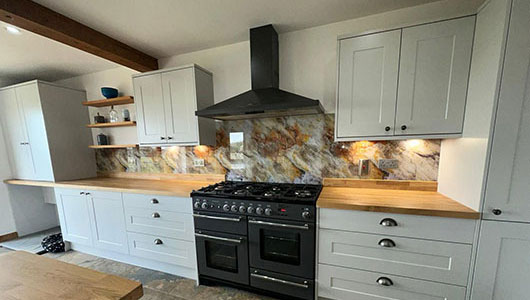
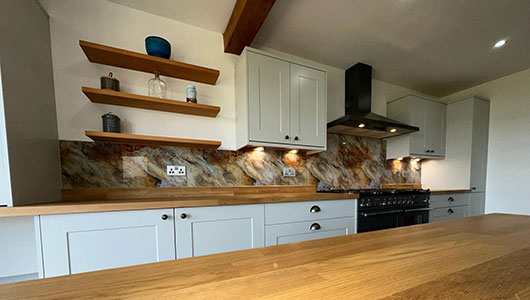
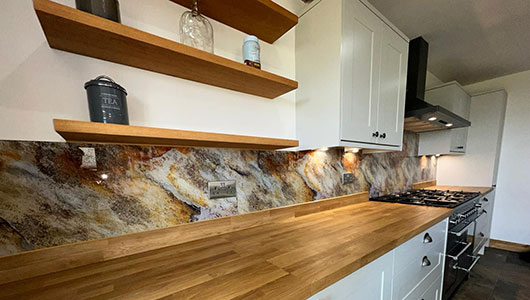
Wonderful customer service
I felt you really cared that we got the best effect for our kitchen and were happy to help us work through the options for as long as it took. Wonderful customer service and the splashback looks great.
(Kitchen splashback using design 010 from our own range)
Mrs Crawford, Aston”
Glass splashbacks in Finchley
There are so many uses for glass in and around your Finchley home. Most people think of the windows and possibly the doors, but did you realise just how good toughened glass can look as a splashback behind your bathroom basin, kitchen sink or cooker? Glass even looks fantastic when used as a worktop or worktop cover. Glass is easy to keep clean and streak free with the minimum of fuss and it's very hygienic too. In the catering industry, stainless steel has been used for many years but over a relatively short time can become badly scratched, which in turn harbours a lot of bacteria. Glass is now being introduced to the professional kitchens up and down the country as it is not prone to the same fate as stainless steel. Splashbacks of Distinction has installed glass splashbacks in a couple of hotel kitchens in the Finchley area recently. The toughened glass we used replaced the quarry tiled splashbacks that were particularly grubby behind the cooker and the Perspex splashback that was behind the pot washers sinks. Why not join our happy band of satisfied customers by calling Splashbacks of Distinction today?
Finchley history
It is thought that Finchley most probably means "Finch's clearing" or "finches' clearing" in late Anglo-Saxon; the name was first recorded in the early 13th century. Finchley is not recorded in the Domesday Book, but by the 11th century its lands were held by the Bishop of London. In the early medieval period Finchley was sparsely populated woodland, whose inhabitants made their living by supplying pigs and fuel to London.
Extensive cultivation began about the time of the Norman Conquest. By the 15th and 16th centuries the woods on the eastern side of Finchley had been cleared to form Finchley Common. The medieval Great North Road, which ran through the common, was notorious for highwaymen until the early 19th century and some wealthy travellers would employ out riders to protect them from the armed thieves.
St Mary-at-Finchley Church is first recorded in the 1270s. Near the northern gate to the Bishop of London's park, the hamlet of East End, later East Finchley, had begun to develop by 1365. By the 18th century Finchley was well known for the quality of its hay, which was the dominant agricultural activity until the second half of the 19th century. North Finchley only began to develop after the enclosure of the common during the 1820s.
It formed an ancient parish in the county of Middlesex, originally within the hundred of Ossulstone and later becoming its own urban district, which was then incorporated as a municipal borough in 1933. It has been part of Greater London since 1965.
Finchley is connected via rail
The Edgware, Highgate and London Railway, which later became the Great Northern Railway reached Finchley in 1867. It ran from Finsbury Park via Finchley to Edgware. The branch from Finchley to High Barnet opened in 1872. In 1905 tram services were established in Finchley, and extended shortly afterwards to Barnet. They were eventually replaced by trolleybuses.
In 1933, the Underground New Works Programme to electrify the lines through Finchley, and connect the Northern line from Archway to East Finchley, via a new tunnel was announced. Much of the work was carried out and East Finchley station was rebuilt, but the project was halted by the Second World War. All passenger services from Finchley to Edgware ended in September 1939. Nevertheless, Underground trains began running from central London to High Barnet in 1940, and to Mill Hill East, to reach the army barracks, in 1941.
After the war, the introduction of London's Metropolitan Green Belt undermined pre-war plans and the upgrading between Mill Hill East and Edgware was abandoned, although the line continued to be used by steam trains for goods traffic through Finchley, until 1964.
Splashbacks of Distinction supply the following splashback products in Finchley, London
- Glass kitchen splashbacks
- Glass kitchen splashback samples
- Glass kitchen splashbacks in many different colours
- Printed glass splashbacks
- Colour matched splashbacks
- Painted splashbacks
Splashbacks of Distinction also supply the following glass products in Finchley, London
- Stainless steel and glass Balustrades
- Glass shelves
- Coloured mirrors
- Toughened mirrors
- Decorative glass
- Glass hardware
- Glass worktops
- Glass shower cubicle
- Garden glass balustrades
- Glass staircases
- Glass table tops
- Satin glass
- Toughened glass
- Laminated glass
- Opaque glass
Splashbacks of Distinction also supply the following glass related services in Finchley, London
- Glass cut to size
- Mirrors cut to size while you wait
- Glass processing
- Glass supply and installation
- Supply only splashbacks
- A glass express service
- Template and fit
Only the finest quality from Splashbacks of Distinction
Splashbacks of Distinction ensure that only the finest quality toughened glass is used in all our products. We guarantee all of our work and are fully insured. We employ only trained and certified engineers. Splashbacks of Distinction never leave your property without ensuring you are totally satisfied with your beautiful new glass splashback, baluster, shelving or shower enclosure.
Further Information
If you would like to know more or are interested in a quote we would be happy to help. Phone us on 01920 830 084, email us at enquiries@splashbacksofdistinction.co.uk or fill in our enquiry form and we will be in touch as soon as possible.
Areas covered in London:
- Arkley, London - Kitchen splashbacks | Bathroom splashbacks | Splashbacks with High Resolution Pictures | Glass Balustrades | Glass Shelves | Bespoke Mirrors | Bespoke Shower Screens and Enclosures | Acrylic Splashbacks | Glass splashbacks | Glass Worktops
- Barnet, London - Kitchen splashbacks | Bathroom splashbacks | Splashbacks with High Resolution Pictures | Glass Balustrades | Glass Shelves | Bespoke Mirrors | Bespoke Shower Screens and Enclosures | Acrylic Splashbacks | Glass splashbacks | Glass Worktops
- Battersea, London - Kitchen splashbacks | Bathroom splashbacks | Splashbacks with High Resolution Pictures | Glass Balustrades | Glass Shelves | Bespoke Mirrors | Bespoke Shower Screens and Enclosures | Acrylic Splashbacks | Glass splashbacks | Glass Worktops
- Beckton, London - Kitchen splashbacks | Bathroom splashbacks | Splashbacks with High Resolution Pictures | Glass Balustrades | Glass Shelves | Bespoke Mirrors | Bespoke Shower Screens and Enclosures | Acrylic Splashbacks | Glass splashbacks | Glass Worktops
- Bermondsey, London - Kitchen splashbacks | Bathroom splashbacks | Splashbacks with High Resolution Pictures | Glass Balustrades | Glass Shelves | Bespoke Mirrors | Bespoke Shower Screens and Enclosures | Acrylic Splashbacks | Glass splashbacks | Glass Worktops
- Bethnal Green, London - Kitchen splashbacks | Bathroom splashbacks | Splashbacks with High Resolution Pictures | Glass Balustrades | Glass Shelves | Bespoke Mirrors | Bespoke Shower Screens and Enclosures | Acrylic Splashbacks | Glass splashbacks | Glass Worktops
- Bexley, London - Kitchen splashbacks | Bathroom splashbacks | Splashbacks with High Resolution Pictures | Glass Balustrades | Glass Shelves | Bespoke Mirrors | Bespoke Shower Screens and Enclosures | Acrylic Splashbacks | Glass splashbacks | Glass Worktops
- Bexley Heath, London - Kitchen splashbacks | Bathroom splashbacks | Splashbacks with High Resolution Pictures | Glass Balustrades | Glass Shelves | Bespoke Mirrors | Bespoke Shower Screens and Enclosures | Acrylic Splashbacks | Glass splashbacks | Glass Worktops
- Blackheath, London - Kitchen splashbacks | Bathroom splashbacks | Splashbacks with High Resolution Pictures | Glass Balustrades | Glass Shelves | Bespoke Mirrors | Bespoke Shower Screens and Enclosures | Acrylic Splashbacks | Glass splashbacks | Glass Worktops
- Bow, London - Kitchen splashbacks | Bathroom splashbacks | Splashbacks with High Resolution Pictures | Glass Balustrades | Glass Shelves | Bespoke Mirrors | Bespoke Shower Screens and Enclosures | Acrylic Splashbacks | Glass splashbacks | Glass Worktops
- Brixton, London - Kitchen splashbacks | Bathroom splashbacks | Splashbacks with High Resolution Pictures | Glass Balustrades | Glass Shelves | Bespoke Mirrors | Bespoke Shower Screens and Enclosures | Acrylic Splashbacks | Glass splashbacks | Glass Worktops
- Bromley, London - Kitchen splashbacks | Bathroom splashbacks | Splashbacks with High Resolution Pictures | Glass Balustrades | Glass Shelves | Bespoke Mirrors | Bespoke Shower Screens and Enclosures | Acrylic Splashbacks | Glass splashbacks | Glass Worktops
- Buckhurst Hill, London - Kitchen splashbacks | Bathroom splashbacks | Splashbacks with High Resolution Pictures | Glass Balustrades | Glass Shelves | Bespoke Mirrors | Bespoke Shower Screens and Enclosures | Acrylic Splashbacks | Glass splashbacks | Glass Worktops
- Camberwell, London - Kitchen splashbacks | Bathroom splashbacks | Splashbacks with High Resolution Pictures | Glass Balustrades | Glass Shelves | Bespoke Mirrors | Bespoke Shower Screens and Enclosures | Acrylic Splashbacks | Glass splashbacks | Glass Worktops
- Camden, London - Kitchen splashbacks | Bathroom splashbacks | Splashbacks with High Resolution Pictures | Glass Balustrades | Glass Shelves | Bespoke Mirrors | Bespoke Shower Screens and Enclosures | Acrylic Splashbacks | Glass splashbacks | Glass Worktops
- Chadwell Heath, London - Kitchen splashbacks | Bathroom splashbacks | Splashbacks with High Resolution Pictures | Glass Balustrades | Glass Shelves | Bespoke Mirrors | Bespoke Shower Screens and Enclosures | Acrylic Splashbacks | Glass splashbacks | Glass Worktops
- Chigwell, London - Kitchen splashbacks | Bathroom splashbacks | Splashbacks with High Resolution Pictures | Glass Balustrades | Glass Shelves | Bespoke Mirrors | Bespoke Shower Screens and Enclosures | Acrylic Splashbacks | Glass splashbacks | Glass Worktops
- Chelsea, London - Kitchen splashbacks | Bathroom splashbacks | Splashbacks with High Resolution Pictures | Glass Balustrades | Glass Shelves | Bespoke Mirrors | Bespoke Shower Screens and Enclosures | Acrylic Splashbacks | Glass splashbacks | Glass Worktops
- Chingford, London - Kitchen splashbacks | Bathroom splashbacks | Splashbacks with High Resolution Pictures | Glass Balustrades | Glass Shelves | Bespoke Mirrors | Bespoke Shower Screens and Enclosures | Acrylic Splashbacks | Glass splashbacks | Glass Worktops
- Clapham, London - Kitchen splashbacks | Bathroom splashbacks | Splashbacks with High Resolution Pictures | Glass Balustrades | Glass Shelves | Bespoke Mirrors | Bespoke Shower Screens and Enclosures | Acrylic Splashbacks | Glass splashbacks | Glass Worktops
- Clapton, London - Kitchen splashbacks | Bathroom splashbacks | Splashbacks with High Resolution Pictures | Glass Balustrades | Glass Shelves | Bespoke Mirrors | Bespoke Shower Screens and Enclosures | Acrylic Splashbacks | Glass splashbacks | Glass Worktops
- Crayford, London - Kitchen splashbacks | Bathroom splashbacks | Splashbacks with High Resolution Pictures | Glass Balustrades | Glass Shelves | Bespoke Mirrors | Bespoke Shower Screens and Enclosures | Acrylic Splashbacks | Glass splashbacks | Glass Worktops
- Croydon, London - Kitchen splashbacks | Bathroom splashbacks | Splashbacks with High Resolution Pictures | Glass Balustrades | Glass Shelves | Bespoke Mirrors | Bespoke Shower Screens and Enclosures | Acrylic Splashbacks | Glass splashbacks | Glass Worktops
- Crystal Palace, London - Kitchen splashbacks | Bathroom splashbacks | Splashbacks with High Resolution Pictures | Glass Balustrades | Glass Shelves | Bespoke Mirrors | Bespoke Shower Screens and Enclosures | Acrylic Splashbacks | Glass splashbacks | Glass Worktops
- Dartford, London - Kitchen splashbacks | Bathroom splashbacks | Splashbacks with High Resolution Pictures | Glass Balustrades | Glass Shelves | Bespoke Mirrors | Bespoke Shower Screens and Enclosures | Acrylic Splashbacks | Glass splashbacks | Glass Worktops
- Dulwich, London - Kitchen splashbacks | Bathroom splashbacks | Splashbacks with High Resolution Pictures | Glass Balustrades | Glass Shelves | Bespoke Mirrors | Bespoke Shower Screens and Enclosures | Acrylic Splashbacks | Glass splashbacks | Glass Worktops
- Elm Park, London - Kitchen splashbacks | Bathroom splashbacks | Splashbacks with High Resolution Pictures | Glass Balustrades | Glass Shelves | Bespoke Mirrors | Bespoke Shower Screens and Enclosures | Acrylic Splashbacks | Glass splashbacks | Glass Worktops
- Eltham, London - Kitchen splashbacks | Bathroom splashbacks | Splashbacks with High Resolution Pictures | Glass Balustrades | Glass Shelves | Bespoke Mirrors | Bespoke Shower Screens and Enclosures | Acrylic Splashbacks | Glass splashbacks | Glass Worktops
- Enfield, London - Kitchen splashbacks | Bathroom splashbacks | Splashbacks with High Resolution Pictures | Glass Balustrades | Glass Shelves | Bespoke Mirrors | Bespoke Shower Screens and Enclosures | Acrylic Splashbacks | Glass splashbacks | Glass Worktops
- Fulham, London - Kitchen splashbacks | Bathroom splashbacks | Splashbacks with High Resolution Pictures | Glass Balustrades | Glass Shelves | Bespoke Mirrors | Bespoke Shower Screens and Enclosures | Acrylic Splashbacks | Glass splashbacks | Glass Worktops
- Greenford, London - Kitchen splashbacks | Bathroom splashbacks | Splashbacks with High Resolution Pictures | Glass Balustrades | Glass Shelves | Bespoke Mirrors | Bespoke Shower Screens and Enclosures | Acrylic Splashbacks | Glass splashbacks | Glass Worktops
- Greenwich, London - Kitchen splashbacks | Bathroom splashbacks | Splashbacks with High Resolution Pictures | Glass Balustrades | Glass Shelves | Bespoke Mirrors | Bespoke Shower Screens and Enclosures | Acrylic Splashbacks | Glass splashbacks | Glass Worktops
- Hackney, London - Kitchen splashbacks | Bathroom splashbacks | Splashbacks with High Resolution Pictures | Glass Balustrades | Glass Shelves | Bespoke Mirrors | Bespoke Shower Screens and Enclosures | Acrylic Splashbacks | Glass splashbacks | Glass Worktops
- Hadley Wood, London - Kitchen splashbacks | Bathroom splashbacks | Splashbacks with High Resolution Pictures | Glass Balustrades | Glass Shelves | Bespoke Mirrors | Bespoke Shower Screens and Enclosures | Acrylic Splashbacks | Glass splashbacks | Glass Worktops
- Hammersmith, London - Kitchen splashbacks | Bathroom splashbacks | Splashbacks with High Resolution Pictures | Glass Balustrades | Glass Shelves | Bespoke Mirrors | Bespoke Shower Screens and Enclosures | Acrylic Splashbacks | Glass splashbacks | Glass Worktops
- Hampstead, London - Kitchen splashbacks | Bathroom splashbacks | Splashbacks with High Resolution Pictures | Glass Balustrades | Glass Shelves | Bespoke Mirrors | Bespoke Shower Screens and Enclosures | Acrylic Splashbacks | Glass splashbacks | Glass Worktops
- Harold Wood, London - Kitchen splashbacks | Bathroom splashbacks | Splashbacks with High Resolution Pictures | Glass Balustrades | Glass Shelves | Bespoke Mirrors | Bespoke Shower Screens and Enclosures | Acrylic Splashbacks | Glass splashbacks | Glass Worktops
- Harrow, London - Kitchen splashbacks | Bathroom splashbacks | Splashbacks with High Resolution Pictures | Glass Balustrades | Glass Shelves | Bespoke Mirrors | Bespoke Shower Screens and Enclosures | Acrylic Splashbacks | Glass splashbacks | Glass Worktops
- Havering, London - Kitchen splashbacks | Bathroom splashbacks | Splashbacks with High Resolution Pictures | Glass Balustrades | Glass Shelves | Bespoke Mirrors | Bespoke Shower Screens and Enclosures | Acrylic Splashbacks | Glass splashbacks | Glass Worktops
- Hendon, London - Kitchen splashbacks | Bathroom splashbacks | Splashbacks with High Resolution Pictures | Glass Balustrades | Glass Shelves | Bespoke Mirrors | Bespoke Shower Screens and Enclosures | Acrylic Splashbacks | Glass splashbacks | Glass Worktops
- Highams Park, London - Kitchen splashbacks | Bathroom splashbacks | Splashbacks with High Resolution Pictures | Glass Balustrades | Glass Shelves | Bespoke Mirrors | Bespoke Shower Screens and Enclosures | Acrylic Splashbacks | Glass splashbacks | Glass Worktops
- Highgate, London - Kitchen splashbacks | Bathroom splashbacks | Splashbacks with High Resolution Pictures | Glass Balustrades | Glass Shelves | Bespoke Mirrors | Bespoke Shower Screens and Enclosures | Acrylic Splashbacks | Glass splashbacks | Glass Worktops
- Hillingdon, London - Kitchen splashbacks | Bathroom splashbacks | Splashbacks with High Resolution Pictures | Glass Balustrades | Glass Shelves | Bespoke Mirrors | Bespoke Shower Screens and Enclosures | Acrylic Splashbacks | Glass splashbacks | Glass Worktops
- Hornchurch, London - Kitchen splashbacks | Bathroom splashbacks | Splashbacks with High Resolution Pictures | Glass Balustrades | Glass Shelves | Bespoke Mirrors | Bespoke Shower Screens and Enclosures | Acrylic Splashbacks | Glass splashbacks | Glass Worktops
- Hounslow, London - Kitchen splashbacks | Bathroom splashbacks | Splashbacks with High Resolution Pictures | Glass Balustrades | Glass Shelves | Bespoke Mirrors | Bespoke Shower Screens and Enclosures | Acrylic Splashbacks | Glass splashbacks | Glass Worktops
- Ilford, London - Kitchen splashbacks | Bathroom splashbacks | Splashbacks with High Resolution Pictures | Glass Balustrades | Glass Shelves | Bespoke Mirrors | Bespoke Shower Screens and Enclosures | Acrylic Splashbacks | Glass splashbacks | Glass Worktops
- Islington, London - Kitchen splashbacks | Bathroom splashbacks | Splashbacks with High Resolution Pictures | Glass Balustrades | Glass Shelves | Bespoke Mirrors | Bespoke Shower Screens and Enclosures | Acrylic Splashbacks | Glass splashbacks | Glass Worktops
- Kensington, London - Kitchen splashbacks | Bathroom splashbacks | Splashbacks with High Resolution Pictures | Glass Balustrades | Glass Shelves | Bespoke Mirrors | Bespoke Shower Screens and Enclosures | Acrylic Splashbacks | Glass splashbacks | Glass Worktops
- Lewisham, London - Kitchen splashbacks | Bathroom splashbacks | Splashbacks with High Resolution Pictures | Glass Balustrades | Glass Shelves | Bespoke Mirrors | Bespoke Shower Screens and Enclosures | Acrylic Splashbacks | Glass splashbacks | Glass Worktops
- Loughton, London - Kitchen splashbacks | Bathroom splashbacks | Splashbacks with High Resolution Pictures | Glass Balustrades | Glass Shelves | Bespoke Mirrors | Bespoke Shower Screens and Enclosures | Acrylic Splashbacks | Glass splashbacks | Glass Worktops
- Mill Hill, London - Kitchen splashbacks | Bathroom splashbacks | Splashbacks with High Resolution Pictures | Glass Balustrades | Glass Shelves | Bespoke Mirrors | Bespoke Shower Screens and Enclosures | Acrylic Splashbacks | Glass splashbacks | Glass Worktops
- Mitcham, London - Kitchen splashbacks | Bathroom splashbacks | Splashbacks with High Resolution Pictures | Glass Balustrades | Glass Shelves | Bespoke Mirrors | Bespoke Shower Screens and Enclosures | Acrylic Splashbacks | Glass splashbacks | Glass Worktops
- Mortlake, London - Kitchen splashbacks | Bathroom splashbacks | Splashbacks with High Resolution Pictures | Glass Balustrades | Glass Shelves | Bespoke Mirrors | Bespoke Shower Screens and Enclosures | Acrylic Splashbacks | Glass splashbacks | Glass Worktops
- Northolt, London - Kitchen splashbacks | Bathroom splashbacks | Splashbacks with High Resolution Pictures | Glass Balustrades | Glass Shelves | Bespoke Mirrors | Bespoke Shower Screens and Enclosures | Acrylic Splashbacks | Glass splashbacks | Glass Worktops
- Notting Hill, London - Kitchen splashbacks | Bathroom splashbacks | Splashbacks with High Resolution Pictures | Glass Balustrades | Glass Shelves | Bespoke Mirrors | Bespoke Shower Screens and Enclosures | Acrylic Splashbacks | Glass splashbacks | Glass Worktops
- Peckham, London - Kitchen splashbacks | Bathroom splashbacks | Splashbacks with High Resolution Pictures | Glass Balustrades | Glass Shelves | Bespoke Mirrors | Bespoke Shower Screens and Enclosures | Acrylic Splashbacks | Glass splashbacks | Glass Worktops
- Penge, London - Kitchen splashbacks | Bathroom splashbacks | Splashbacks with High Resolution Pictures | Glass Balustrades | Glass Shelves | Bespoke Mirrors | Bespoke Shower Screens and Enclosures | Acrylic Splashbacks | Glass splashbacks | Glass Worktops
- Pinner, London - Kitchen splashbacks | Bathroom splashbacks | Splashbacks with High Resolution Pictures | Glass Balustrades | Glass Shelves | Bespoke Mirrors | Bespoke Shower Screens and Enclosures | Acrylic Splashbacks | Glass splashbacks | Glass Worktops
- Poplar, London - Kitchen splashbacks | Bathroom splashbacks | Splashbacks with High Resolution Pictures | Glass Balustrades | Glass Shelves | Bespoke Mirrors | Bespoke Shower Screens and Enclosures | Acrylic Splashbacks | Glass splashbacks | Glass Worktops
- Richmond, London - Kitchen splashbacks | Bathroom splashbacks | Splashbacks with High Resolution Pictures | Glass Balustrades | Glass Shelves | Bespoke Mirrors | Bespoke Shower Screens and Enclosures | Acrylic Splashbacks | Glass splashbacks | Glass Worktops
- Romford, London - Kitchen splashbacks | Bathroom splashbacks | Splashbacks with High Resolution Pictures | Glass Balustrades | Glass Shelves | Bespoke Mirrors | Bespoke Shower Screens and Enclosures | Acrylic Splashbacks | Glass splashbacks | Glass Worktops
- Ruislip, London - Kitchen splashbacks | Bathroom splashbacks | Splashbacks with High Resolution Pictures | Glass Balustrades | Glass Shelves | Bespoke Mirrors | Bespoke Shower Screens and Enclosures | Acrylic Splashbacks | Glass splashbacks | Glass Worktops
- St Johns Wood, London - Kitchen splashbacks | Bathroom splashbacks | Splashbacks with High Resolution Pictures | Glass Balustrades | Glass Shelves | Bespoke Mirrors | Bespoke Shower Screens and Enclosures | Acrylic Splashbacks | Glass splashbacks | Glass Worktops
- Streatham, London - Kitchen splashbacks | Bathroom splashbacks | Splashbacks with High Resolution Pictures | Glass Balustrades | Glass Shelves | Bespoke Mirrors | Bespoke Shower Screens and Enclosures | Acrylic Splashbacks | Glass splashbacks | Glass Worktops
- Sydenham, London - Kitchen splashbacks | Bathroom splashbacks | Splashbacks with High Resolution Pictures | Glass Balustrades | Glass Shelves | Bespoke Mirrors | Bespoke Shower Screens and Enclosures | Acrylic Splashbacks | Glass splashbacks | Glass Worktops
- Teddington, London - Kitchen splashbacks | Bathroom splashbacks | Splashbacks with High Resolution Pictures | Glass Balustrades | Glass Shelves | Bespoke Mirrors | Bespoke Shower Screens and Enclosures | Acrylic Splashbacks | Glass splashbacks | Glass Worktops
- Tooting, London - Kitchen splashbacks | Bathroom splashbacks | Splashbacks with High Resolution Pictures | Glass Balustrades | Glass Shelves | Bespoke Mirrors | Bespoke Shower Screens and Enclosures | Acrylic Splashbacks | Glass splashbacks | Glass Worktops
- Tottenham, London - Kitchen splashbacks | Bathroom splashbacks | Splashbacks with High Resolution Pictures | Glass Balustrades | Glass Shelves | Bespoke Mirrors | Bespoke Shower Screens and Enclosures | Acrylic Splashbacks | Glass splashbacks | Glass Worktops
- Twickenham, London - Kitchen splashbacks | Bathroom splashbacks | Splashbacks with High Resolution Pictures | Glass Balustrades | Glass Shelves | Bespoke Mirrors | Bespoke Shower Screens and Enclosures | Acrylic Splashbacks | Glass splashbacks | Glass Worktops
- Upminster, London - Kitchen splashbacks | Bathroom splashbacks | Splashbacks with High Resolution Pictures | Glass Balustrades | Glass Shelves | Bespoke Mirrors | Bespoke Shower Screens and Enclosures | Acrylic Splashbacks | Glass splashbacks | Glass Worktops
- Uxbridge, London - Kitchen splashbacks | Bathroom splashbacks | Splashbacks with High Resolution Pictures | Glass Balustrades | Glass Shelves | Bespoke Mirrors | Bespoke Shower Screens and Enclosures | Acrylic Splashbacks | Glass splashbacks | Glass Worktops
- Waltham Forest, London - Kitchen splashbacks | Bathroom splashbacks | Splashbacks with High Resolution Pictures | Glass Balustrades | Glass Shelves | Bespoke Mirrors | Bespoke Shower Screens and Enclosures | Acrylic Splashbacks | Glass splashbacks | Glass Worktops
- West Norwood, London - Kitchen splashbacks | Bathroom splashbacks | Splashbacks with High Resolution Pictures | Glass Balustrades | Glass Shelves | Bespoke Mirrors | Bespoke Shower Screens and Enclosures | Acrylic Splashbacks | Glass splashbacks | Glass Worktops
- Wimbledon, London - Kitchen splashbacks | Bathroom splashbacks | Splashbacks with High Resolution Pictures | Glass Balustrades | Glass Shelves | Bespoke Mirrors | Bespoke Shower Screens and Enclosures | Acrylic Splashbacks | Glass splashbacks | Glass Worktops
- Worcester Park, London - Kitchen splashbacks | Bathroom splashbacks | Splashbacks with High Resolution Pictures | Glass Balustrades | Glass Shelves | Bespoke Mirrors | Bespoke Shower Screens and Enclosures | Acrylic Splashbacks | Glass splashbacks | Glass Worktops

Showroom: Unit 11, Broomhall Farm, Watton At Stone, Hertford SG14 2RN
Splashbacks of Distinction is the trading name of RDC Glass Ltd







